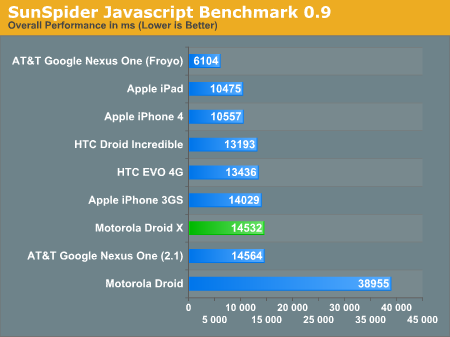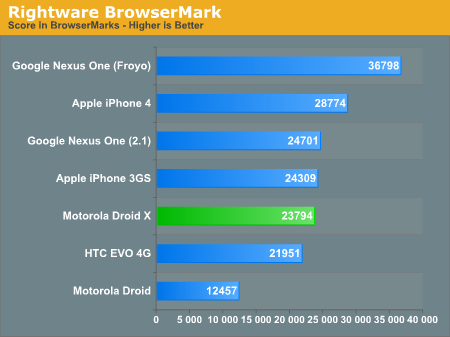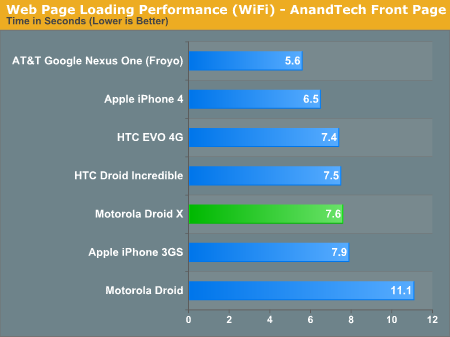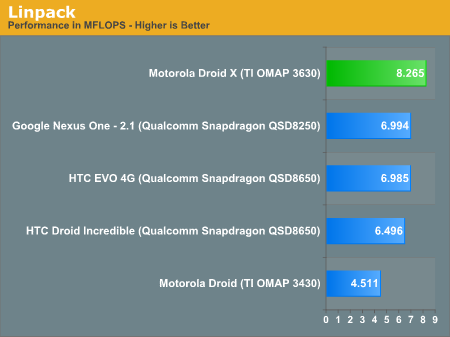Motorola Droid X: Thoroughly Reviewed
by Brian Klug on July 20, 2010 4:27 PM EST- Posted in
- Smartphones
- Motorola Droid X
- OMAP
- Mobile
CPU and General Use Performance
Snapdragon is what Qualcomm calls its SoC, but the CPU itself is called Scorpion. Scorpion is very similar to ARM’s Cortex A8, but with potentially twice the Neon (SIMD FP) throughput. In day to day use however, I don’t expect to see a huge difference between the Scorpion and A8 CPU cores used by Qualcomm and TI respectively.
We’ll start with the targeted browser tests, first SunSpider. A javascript performance test, this benchmark is completely network independent but it measures the performance of the browser as well as the underlying hardware.

SunSpider shows the Droid X roughly on par with the Nexus One running Android 2.1, and a bit slower than the HTC offerings. This benchmark is as much of a software test as it is a hardware one since the move to Froyo (Android 2.2) cuts benchmark times in more than half.
The performance delta from the original Droid to the Droid X is extremely pronounced here. The Droid is just plain slow, and to think it wasn’t that long ago that we were begging manufacturers to use the Cortex A8. The X is a major step forward compared to last year’s high end smartphones.
Next up is the Rightware BrowserMark. This test combines JavaScript and HTML rendering performance:

BrowserMark puts the Droid X in the same league as other Android 2.1 phones. In terms of real world web browsing it doesn’t look like there’s any real difference between the OMAP 3630 and Qualcomm’s Snapdragon.
Turning an eye towards the real world we have a WiFi web page loading test. Here we’ve got a local copy of the AnandTech front page and we’re loading it over WiFi. Note that these results can’t be compared to previous tests as they are running in a slightly different environment than in previous reviews.

The lower level synthetic CPU tests mostly echo our findings thus far - there's very little difference in CPU performance between the OMAP 3630 and Qualcomm's Snapdragon.
The Linpack and Pi tests are very much compiler benchmarks as well as platform tests. We’ve actually had to remove the Froyo Nexus One results from the Linpack graph simply because they make the graph unreadable - Froyo is nearly 3x the speed of the fastest Android 2.1 phone here.


On a relatively level playing field, with all phones running Android 2.1, the Droid X is around twice the speed of the original Droid. The OMAP 3630 even holds a performance advantage over Snapdragon in this test. While Linpack as a workload isn’t very representative of what most people will do with their phones, it is a great FP and cache benchmark.
From a CPU and platform perspective, TI’s OMAP 3630 appears to be just as fast as Qualcomm’s Snapdragon SoC. The two perform very similarly across the board regardless of benchmark. The OMAP most visible advantage is in its GPU. The PowerVR SGX 530, especially running at 200MHz in the OMAP 3630, is at least 50% faster than the present day competition in other Android phones. It should be similar to performance offered by Apple’s A4.










89 Comments
View All Comments
TareX - Thursday, July 22, 2010 - link
Why are all the Samsung Galaxy S phones missing from your charts and comparisons? I wanted to see how Hummingbird compared and how the Super AMOLED fared against their Droid X counterparts...strikeback03 - Tuesday, July 27, 2010 - link
Maybe because the first US version launched a day before the review went up, and they weren't sent a review sample.enealDC - Thursday, July 22, 2010 - link
Great job!Juniper Research - Friday, July 23, 2010 - link
Very interesting article... we have this week published a new report on smartphones and a free whitepaper is available to download here... http://www.juniperresearch.com/reports/next_genera...John Levett
Marketing Executive at Juniper Research
Homefries - Saturday, July 24, 2010 - link
First off, great review Brian.However, while you did a very thorough comparison of the Droid X to other Android devices, you barely mentioned the real competitor the Droid X has to stand up against: the iPhone 4.
Readers want to know if the Droid X is the best phone on the market - the whole market - not just the market subset dedicated to Android devices.
Like the majority of the tech media, your review furthers the notion readers belong exclusively to either the iOS camp or the Andriod camp. This is simply not true. Informed readers, like the ones that peruse Anandtech, want to buy one smartphone, regardless of any marketing slants, that is the best.
Your review of the Droid X should have helped us answer the question, "Should I buy the Droid X or the iPhone 4?" But, it did not.
strikeback03 - Tuesday, July 27, 2010 - link
Well, I think the conclusion in the iPhone article and some earlier Android articles applies, there is no "best" for everyone. Some people love Apple and the Apple way of life, some people won't touch it. As the iPhone is currently limited to AT&T, that is going to deter a lot of people. How large a pocket/bag you plan on carrying the phone in might make size differences more important to some than others. So while I am not one of the readers calling for no subjective opinions (it is interesting that FroYo feels significantly faster/different) I think it is still up to each buyer to decide what is most important to them.Electrofreak - Saturday, July 24, 2010 - link
Brian and Anand, are you sure you're using the correct information regarding the SoC in the Droid X? I believe it is a OMAP 3640, not a 3630, as the maximum recommended clock speed of the 3630 is described in numerous places across the net as being 720 MHz, while the max clock speed of the 3640 is described as 1 GHz. In addition, the max recommended clock speed of the 3430 in the Droid was 600 MHz, not 800.The information I cite above is widely available across the web... if you've got inside information the rest of us don't have, by all means let us know. But as someone who has written articles of my own on ARM SoCs and follows ARM industry news closely, I suspect that your data may not be 100% correct.
Regardless, I do have to thank you for writing some of the most informative hardware articles on the net. I appreciate it!
Electrofreak - Saturday, July 24, 2010 - link
...and I just found this: http://e2e.ti.com/blogs_/b/mobile_momentum/archive...So, per TI's blog it is the 3630... now we just need an explanation of the other info on the web that describes the 3630 as maxing out at 720 MHz.
Brian Klug - Monday, July 26, 2010 - link
Yeah, TI's documentation is a bit outdated. Anand tackled the SoC part, but the 3630 is indeed a 1 GHz part, it isn't the 3640 guaranteed. There was a lot of confusion online about it, but Anand got the official word. ;)I agree, back when I did my other OMAP 3 piece it was 720 MHz.
-Brian
Electrofreak - Saturday, July 24, 2010 - link
Looking forward to that Hummingbird review Brian. I hope you're able to dig up some info that I wasn't able to when I wrote my article (http://alienbabeltech.com/main/?p=17125) back in April.